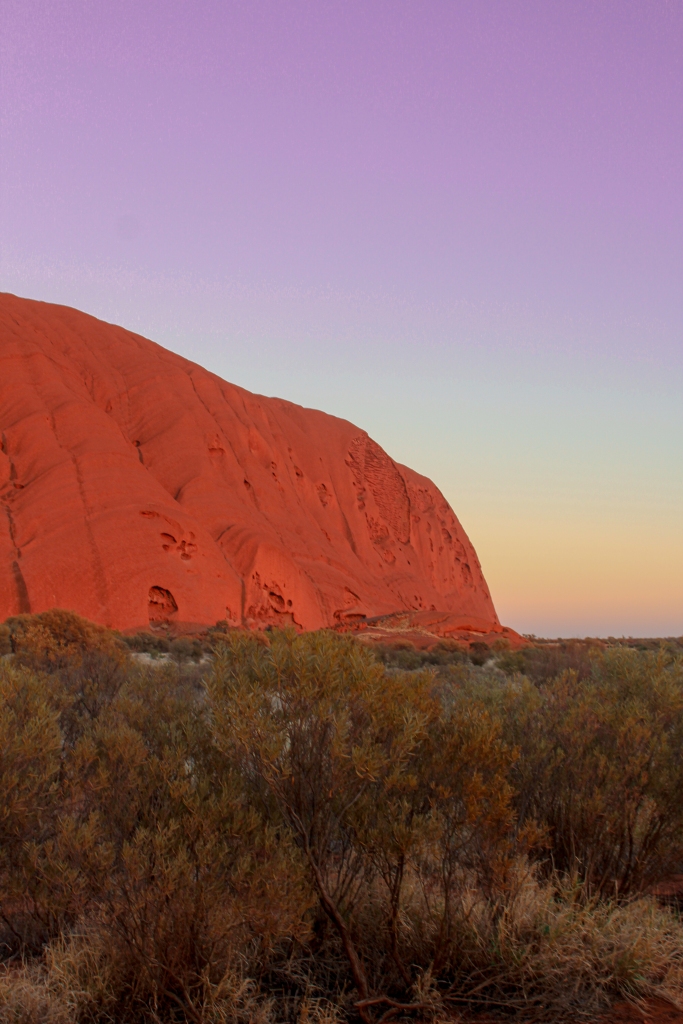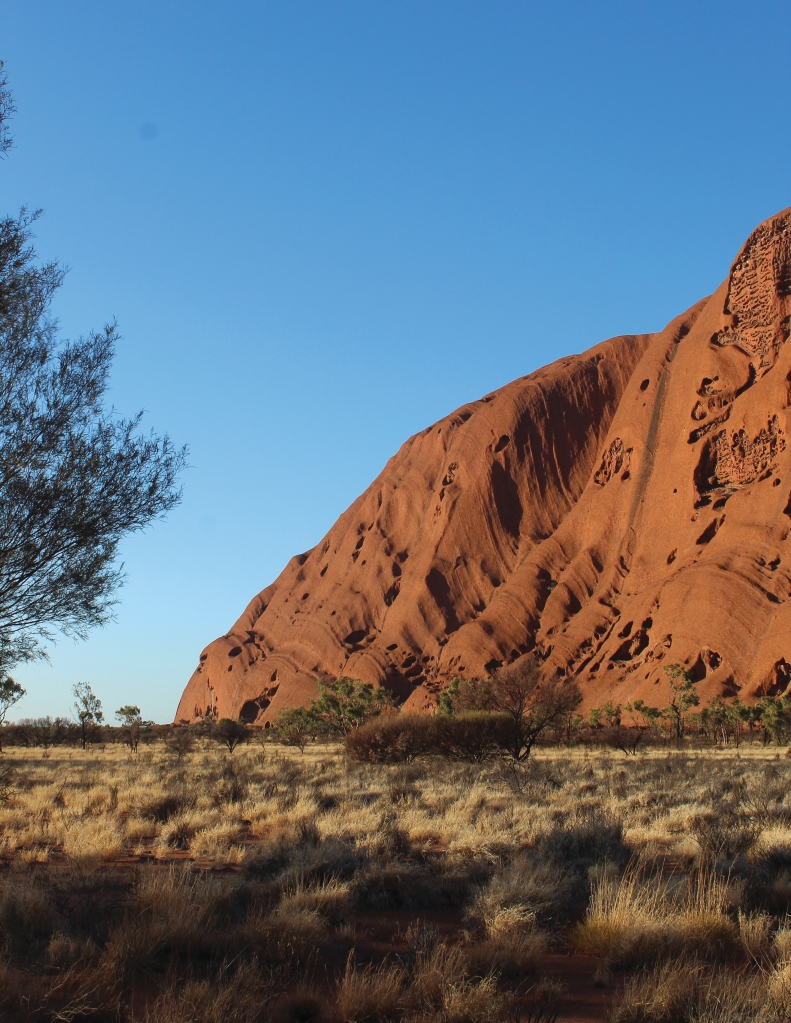While the drive to Uluru-Kata Tjuta National Park was an adventure in and of itself, I was glad when we finally made it to our main attraction. I remember driving and through the desert for hours, watching as the sand and shrubs passed by the window, when finally Uluru came into view. I thought we had finally arrived, but it was still hours away, and the closer we got the more I realize how I had underestimated its size.
Despite spotting Uluru on the horizon, our first stop was nearby at Kata Tjuta which is in the same national park. We started our tour with a short, hour-long hike through the gorge of Kata Tjuta. As the sun started to go down, the walls turned a deep red. The blackish lines on the rock (found at both Uluru and Kata Tjuta) are where the water has run down the surface during periods of rainfall.
What I found fascinating about Uluru’s geology was that during its creation, when it was pushed up from the earth, it was pushed up sideways, so the sediment layers of the sandstone are vertical. The grooves and weathering of Uluru is stunning, absolutely breathtaking.

During our first evening in the national park, we watched the sunset at Uluru. We ate smoked kangaroo and emu sausages, the former was delicious, the latter was not my cup of tea. I actually missed the last of the sun’s beams hitting Uluru before it set because I was talking with some of the Aboriginals that were showcasing their artwork at the viewing sight.
A mother and her child were selling paintings inspired by the story of the Seven Sisters. This creation story focuses on seven sisters who are running from a man who is trying to marry them against their wishes. They plead for help from the spirits of Uluru and are transformed into the constellation known as the Pleiades.
The man that was chasing them then turns himself into the Morning Star (part of Orion’s belt) and continues to chase them in the stars. This constellation is common in multiple cultures, such as Greek mythology, which has a very similar story arc, as well as Native American and Thai folklore, and many more.
Both Karoline and I ended up buying paintings depicting the story, and I bought another one from a man depicting a serpent, goanna and tribe of women. We were extremely lucky that they allowed us to take their photos. For the Anangu, taking photos of them may be against their culture, so it is extremely important to ask or refrain completely from doing so. I’m really starting to accumulate a collection of Aboriginal art, but I honestly wish I had bought more.
That evening back at camp, we gathered around a long banquet table and ate dinner by candlelight. We had kangaroo steak marinated in a honey garlic sauce, and it was one of the best meals I have had. I was honestly surprised by how much I loved it, but part of me felt incredibly guilty for eating it after seeing my beloved Australian icon in person. Just to clarify though, kangaroos are not endangered, far from it actually. They actually have such a large population that culling is required to keep their numbers sustainable.
For dessert, we had an Australian classic: damper. It was traditionally cooked by drovers, swagmen and other travelers, but continues to be an iconic Australian dish. It’s a soda bread cooked in the coals of a campfire. Since ours was for dessert, we added lemonade to the dough to make it sweeter. Then, while the bread was still warm from the fire, we added jam and filled our bellies. I’ve been craving it ever since.
If you’re like me, you might not have imagined the Outback as a place that gets cold, but it got down to freezing temperatures at night while we were there. The first night, we slept in these shed-like rooms that didn’t hold heat whatsoever. I slept in four layers of clothing with two blankets, and I still could feel my body heat seeping out of me and into the mattress.
The next morning, we were up before 5:30 a.m. to make it to Uluru for a sunrise base-walk. It was unbelievably cold, and I did not have anything to keep the wind from breezing through my clothes. Luckily, a kind couple from Switzerland, Patrick and Jasmin, were more prepared and offered me one of their extra windbreakers. The walk was much more enjoyable with it.

The colors of Uluru are truly something to marvel at. They are completely dependent on the angle of the sun in the sky. During sunrise, the entire scene radiated gold. As the sun rose, the temperature became more bearable, and the rock slowly became the classic Outback red. The walk took two hours to make it around half the base. It’s so much bigger than I imagined.
At the time that I visited Uluru, there was an option to climb to the top of the monolith, but the Aboriginal people requested that you don’t out of respect for their sacred land. It was closed the day we went due to strong winds, but I am happy to say the Climb has officially closed as of October 26th, 2019, on the 34th anniversary of the day the land was given back to the traditional owners.
They closed the Climb for multiple reasons, including safety and sanitary reasons along with cultural respect. Uluru is as tall as a 95-story building, making it a very dangerous climb. Many people experience heart attacks after reaching the top, and at least 35 people have died while attempting the Climb.
It takes about three hours to climb, and there are no bathrooms at the top (obviously, it’s a mountain), so a lot of people just go on the top of the rock. This causes major environmental issues as it pollutes the waterholes at the top and base and contaminates the already limited water sources the animals have. There is also heavy litter accumulated on top of Uluru.
I find it pretty despicable that the Climb was ever allowed. There are a lot of tourists who fail to practice environmentally-friendly tourism and culturally appropriate traveling. I am not perfect, but I at least attempt to make myself aware of such practices before visiting a place I am unfamiliar with.
At the end of our walk, Phil was waiting for us and took us to the opposite side of Uluru to do a short guided tour of some of the caves and waterholes. He showed us some of the ancient faded cave paintings that were used to teach the young. One of the meanings that I can remember is that circles symbolize a place of significance (waterholes, sacred ground such as Uluru, etc.) and when they are joined it symbolizes a journey.
We took our last looks at the wonders of Uluru before heading on our way to King’s Canyon.


